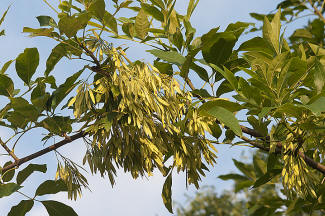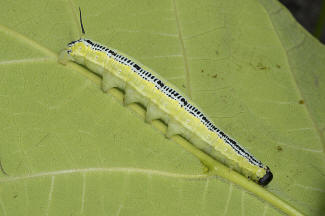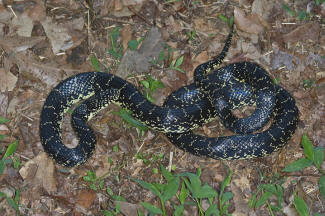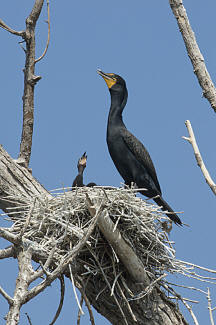PROFILES IN NATURE
Catalpa Worm
Photo Credit – www.kentuckyupclose.com
Common throughout our region is the catalpa tree. Usually found
alongside roadways and around old homesteads it is a valued ornamental
for its large green leaves and fragrant springtime flowers. There is
however another use for these trees.
The Catalpa Worm or Catawba worm is a large caterpillar that may
grow from 2 to 3 inches long. It is the larval form of the Catalpa
Sphinx Moth, Ceratomia catalpa,
which is a large moth with a wingspan of
nearly 3 inches. While common they are not frequently seen as they
mostly fly at night.
The catalpa moth deposits clumps of eggs numbering from 100 to
1000 on the underside of leaves. Once the young caterpillars hatch they
are light yellow to whitish in color and grow rapidly. Adding a bit more
color each time they molt some larger caterpillars may have a solid
black band down their back. Following the final molt or instar the
caterpillar will go into a “wandering stage” where it will find a
suitable place to go underground and pupate. In this area there are
usually multiple broods per year. If it is one of the earlier broods
this pupa will hatch into a mature moth in a few weeks. If it is the
last brood of the year then this is the form that will overwinter and
emerge as an adult the following spring once foliage is present for
food.
Catalpa worms are specific feeders. They will not feed on any
other leaves other than that of the catalpa tree. With a heavy
infestation these trees may sometimes be defoliated but this seems to
not damage the tree as they will soon leaf out again.
Well known for their excellence as fish bait, catalpa worms are
gathered by many for this use. There is actually a small market where
they are farmed and preserved for use as such. They even hold up fairly
well frozen for a few weeks.
© 2015 Jack
Glisson of WWW.kentuckyupclose.com
Published in The Ballard County Weekly 07/08/2015
PROFILES IN NATURE
Green Ash

Photo Credit – www.kentuckyupclose.com
Driving around this region during early summer one may have
noticed wads of light green seeds hanging in several trees. The ones
shown above belong to the Green Ash Tree, scientific name
Fraxinus pennsylvanica.
One of our native trees the green ash is common throughout our
area, preferring low lying or waste areas. The white ash however tends
to grow in mature forest.
The lumber of both trees is tough and has many uses. One of the
best known uses for white ash is for baseball bats and longbows. Wood
from both trees make good tool handles and both are widely used in
making electric guitar bodies.
Besides the lumber being useful, the seeds are important mast
crops for several species of birds, mice and squirrels.
© 2015 Jack
Glisson of WWW.kentuckyupclose.com
Published in The Ballard County Weekly 07/15/2015
PROFILES IN NATURE
Eastern Kingsnake
Photo Credit – www.kentuckyupclose.com
The eastern Kingsnake,
Lampropeltis getula, can be quite varied in coloration throughout
our region. Sub-species can vary from the black kingsnake which may be
found in far Eastern Kentucky to the speckled kingsnake from Misouri and
near the Mississippi River. Just like the name implies the black
kingsnake is solid black above while the speckled kingsnake has a white
or yellow colored speck on each scale. In between there are any number
of variations but most show a chain like pattern on a black background.
The amount of white in the chain pattern and specks are what varies and
this snake is generally thought to be an intergrade of the previous two
mentioned sub-species. All of these snakes have a few things in common,
smooth and shiny scales and a light colored belly with square darker
colored blotches.
Even to folks that don’t like snakes in general the kingsnake
should be considered a friend. They eat a variety of food including rats
and mice, birds, amphibians, reptiles, and yes, even other snakes. The
kingsnake is immune to the venom of local pit vipers and therefore will
readily prey on them.
Kingsnakes lay from six to twenty eggs. The young are marked
similar to adults but the light colored pattern is brighter.
These snakes are not aggressive unless provoked. Beneficial
around farms and homes due to their predation on mice and venomous
snakes these docile snakes are better left alone.
© 2015 Jack Glisson
of WWW.kentuckyupclose.com
Published in The Ballard County Weekly 07/22/2015
PROFILES IN NATURE
Double-crested Cormorant
© 2015 Jack Glisson of
WWW.kentuckyupclose.com
Usually seen flying low over the water or floating along is the
Double-crested Cormorant,
Phalacrocorax auritus. These birds are fairly common along all the
major waterways and lakes in this area. If one looks in some of the bird
books however this part of the country is listed as a winter haven or
migratory stop. As seen in this photo though, they do have breeding
colonies in Western Kentucky.
These cormorants are pretty easy to recognize. When setting in
water they ride low in the surface and usually fly just above the water
surface. They dive to catch fish and after feeding may be found perching
on some surface with wings spread to dry out.
The name Double-crested comes from two tufts of feathers on each
side of the head. However these tufts are only seen during breeding
season.
Nesting colonies are usually found over water or perhaps on small
islands. Nests are constructed mostly of sticks and anywhere from one to
seven eggs are laid. Depending on the season and location one to two
broods may be raised.
Feeding almost exclusively on fish they are well equipped with
webbed feet to aid in diving for the capture.
Cormorants have less oil for their feathers than other water
birds. This is one reason they set so low in the water and when taking
off to fly look like they are running on the surface until they can gain
flight. This is also the reason they can frequently be found setting
with their wings stretched, drying them out.
Published in The Ballard County Weekly 07/29/2015


